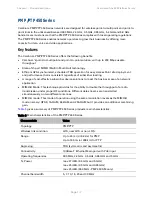
Chapter 1: Product description
Overview of the 450 Platform Family
Page 1-7
PMP/PTP 450 Series
Cambium PMP/PTP 450 Series networks are designed for wireless point-to-multipoint and point-to-
point links in the unlicensed/licensed 900 MHz, 2.4 GHz, 3.5 GHz, 3.65 GHz, 5.4 GHz and 5.8 GHz
bands. Users must ensure that the PMP/PTP 450 Series complies with local operating regulations.
The PMP/PTP 450 Series enables network operators to grow their business by offering more
capacity for data, voice and video applications.
Key features
The Cambium PMP/PTP 450 Series offers the following benefits:
Cambium’s point-to-multipoint and point-to-point solution, with up to 230 Mbps usable
throughput
State-of-the-art MIMO (Multi In Multi Out) technology
Efficient GPS synchronized, scheduled TDD operation for easy Access Point site deployment
and performance that is consistent regardless of subscriber loading
A range of cost-effective subscriber device solutions to meet the business case of a network
application
MIMO-B Mode: This technique provides for the ability to double the throughput of a radio
transmission under proper RF conditions. Different data streams are transmitted
simultaneously on two different antennas.
MIMO-A mode: This mode of operation using the same modulation levels as the MIMO-B
mode, namely: QPSK, 16-QAM, 64-QAM and 256-QAM but it provides an additional combining
gain.
Table 5
gives a summary of PMP/PTP 450 Series products main characteristics .
Table 5 Main characteristics of the PMP/PTP 450 Series
Characteristic
Value
Topology PMP/PTP
Wireless link condition
LOS, near LOS or non-LOS
Range
Up to 40 mi (or 64 km) for PMP
Up to 186 mi (or 299 km) for PTP
Duplexing
TDD (symmetric and asymmetric)
Connectivity
100Base-T Ethernet Main port with PoE input
Operating frequencies
900 MHz, 2.4 GHz, 3.5 GHz, 3.65 GHz and 5 GHz
Tx Power
max 27 dBm (2.4 GHz and 5 GHz)
max 25 dBm (3.5 GHz and 3.65 GHz)
max 25 dBm (900 MHz - PMP 450 SM only)
Channel bandwidth
5, 7, 10, 15, 20 and 30 MHz
Содержание PMP 450d Series
Страница 101: ...Chapter 2 System hardware GPS synchronization Page 2 40 Figure 25 Cluster Management Scenario 1 ...
Страница 125: ...Chapter 3 System planning Typical deployment Page 3 3 Figure 37 Wall installation ...
Страница 126: ...Chapter 3 System planning Typical deployment Page 3 4 Figure 38 Roof installation ...
Страница 127: ...Chapter 3 System planning Typical deployment Page 3 5 Figure 39 GPS receiver wall installation ...
Страница 128: ...Chapter 3 System planning Typical deployment Page 3 6 Figure 40 GPS receiver tower or mast installation ...















































